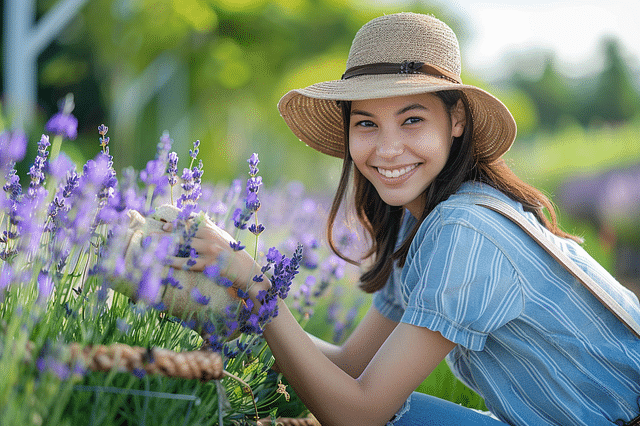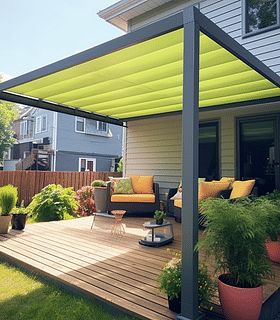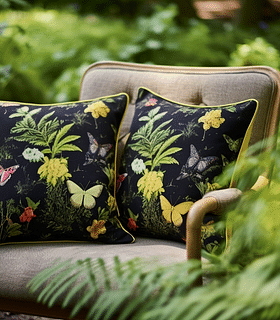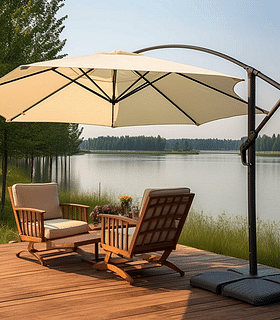How to grow lavender and create a beautiful garden
Learn how to grow lavender and create a stunning garden oasis. Discover expert tips and tricks for cultivating and caring for lavender plants. Perfect for garden enthusiasts and DIY lovers.

Have you ever dreamt of having a beautiful garden filled with fragrant flowers? Picture yourself basking in the gentle breeze, surrounded by vibrant colors and delicate petals. One flower that can bring this dream to life is lavender. Known for its enchanting aroma and stunning purple blooms, lavender can transform any garden into a sanctuary of tranquility and beauty.
In this blog post, we will guide you through the process of growing lavender and creating a breathtaking garden that will make your neighbors green with envy. Whether you're a gardening enthusiast or a beginner with a green thumb, we've got you covered with simple and practical tips that will ensure your success.
Are you ready to embark on this aromatic journey? Let's dive in and discover the secrets to growing lavender and designing a garden that will captivate your senses and bring joy to your soul.
The Beauty and Benefits of Lavender

Lavender is a beautiful and versatile plant that offers a host of benefits, both for your garden and for your overall well-being. Its lovely scent, delicate flowers, and calming properties make it a favorite among gardeners and essential oil enthusiasts alike. In this section, we will explore the different varieties of lavender, the benefits of growing it in your garden, and some popular ways to use this incredible plant.
What are the different varieties of lavender?
Lavender comes in a variety of species and cultivars, each with its own unique characteristics. Some of the most popular varieties include:
English Lavender (Lavandula angustifolia): This is the most common type of lavender and is known for its compact size and fragrant flowers. It is prized for its essential oil, which is often used in aromatherapy.
French Lavender (Lavandula stoechas): French lavender is characterized by its distinctive "rabbit ear" flowers, which add a touch of whimsy to any garden. It is also known for its strong fragrance and ability to attract bees and butterflies.
Spanish Lavender (Lavandula stoechas): With its vibrant purple flowers and unique bracts, Spanish lavender is a showstopper in any garden. It is drought-tolerant and thrives in warmer climates.
Lavandin (Lavandula x intermedia): Lavandin is a hybrid variety, created by crossing English lavender with spike lavender. It is larger and more vigorous than English lavender and is often grown for its abundant flowers and aromatic oils.
What are the benefits of growing lavender in your garden?
Aside from its beauty and fragrance, growing lavender in your garden offers numerous benefits. Here are a few reasons why you should consider adding this delightful plant to your outdoor space:
Pest repellent: Lavender is known to repel pests like mosquitoes, flies, and moths, making it a natural and non-toxic alternative to chemical insecticides.
Pollinator attractant: Bees, butterflies, and other beneficial insects are attracted to the nectar-rich flowers of lavender. By planting lavender in your garden, you can create a haven for these important pollinators.
Stress relief: The scent of lavender has long been associated with relaxation and stress relief. Having lavender plants in your garden allows you to enjoy their calming aroma and unwind after a long day.
Medicinal properties: Lavender has been used for centuries in herbal medicine for its various health benefits. It is known to have antimicrobial, anti-inflammatory, and analgesic properties, making it a valuable addition to your natural medicine cabinet.
What are some popular ways to use lavender?
Lavender's versatility extends beyond the garden. Here are a few popular ways to use lavender in your daily life:
Aromatherapy: The calming scent of lavender essential oil can be diffused in your home to create a relaxing atmosphere or added to bathwater for a soothing soak.
Skincare: Lavender oil is often used in skincare products for its soothing and nourishing properties. It can help to calm irritated skin, reduce inflammation, and promote a clear complexion.
Culinary uses: Culinary lavender can be used to add a floral note to various dishes and beverages. It pairs well with sweet treats like cookies and cakes, as well as with savory dishes like roasted vegetables or grilled meats.
Crafts and decoration: Dried lavender flowers can be used in crafts, potpourri, or homemade sachets to add a lovely scent to your home. They can also be used to create beautiful floral arrangements or wreaths.
By exploring the different varieties of lavender, understanding the benefits of growing it in your garden, and discovering popular ways to use it, you can fully appreciate the beauty and versatility of this remarkable plant.
Choosing the Right Location for Your Lavender Garden

When it comes to creating a beautiful lavender garden, choosing the right location is key. Lavender plants thrive in specific environmental conditions, and by providing them with the right amount of sunlight, soil type, and spacing, you can ensure a successful and vibrant lavender garden. In this section, we will explore the important factors to consider when selecting the ideal location for your lavender garden.
What are the sunlight requirements for lavender plants?
Lavender plants are known for their love of sunshine. They require at least 6 to 8 hours of direct sunlight each day to thrive and produce abundant blooms. When selecting a location for your lavender garden, look for an area that receives full sun throughout the day. This can be a sunny spot in your backyard, a rooftop garden, or even a balcony with ample sunlight exposure. By providing your lavender plants with the sunshine they need, you'll ensure optimal growth and flowering.
What type of soil is best for growing lavender?
Lavender plants prefer well-draining soil with a slightly alkaline pH level. They do not thrive in heavy clay or waterlogged soils, as excess moisture can cause root rot and other issues. Sandy or loamy soil types are ideal for lavender, as they provide good drainage and allow air to circulate around the roots. If you have heavy clay soil, you can improve its drainage by adding organic matter such as compost or sand. Before planting lavender, it's also a good idea to test the pH level of your soil and make any necessary adjustments to ensure it falls within the slightly alkaline range of 6.5 to 7.5.
How should you space the lavender plants in your garden?
When it comes to spacing lavender plants, it's important to give them enough room to grow and thrive. Proper spacing allows for adequate air circulation, which helps prevent diseases and promotes healthy growth. For most lavender varieties, a spacing of 12 to 18 inches between each plant is recommended. This allows the plants to have enough space to spread out and reduces competition for nutrients and sunlight. However, certain larger lavender varieties may require wider spacing, so it's always a good idea to check the specific requirements for the variety you choose to plant.
Can lavender be grown in containers?
Yes, lavender can be successfully grown in containers, making it a versatile choice for those with limited garden space or who prefer to have their plants in pots. When growing lavender in containers, it's important to choose a pot with good drainage holes to prevent waterlogged soil. Select a pot that is at least 12 inches in diameter to provide ample space for the roots to grow. Fill the container with a well-draining potting mix, specifically designed for container gardening. Place your lavender plant in a sunny location, and water it regularly, allowing the soil to dry out slightly between waterings. Container-grown lavender can add a lovely touch of beauty and fragrance to patios, balconies, and any other outdoor space.
Choosing the right location for your lavender garden is crucial for the success of your plants. By considering the sunlight requirements, soil type, spacing, and the option of growing lavender in containers, you'll create an optimal environment for your lavender plants to flourish and delight your senses.
Planting and Caring for Lavender

Lavender is a beautiful and versatile plant that adds a touch of elegance to any garden or landscape. Not only does it have a lovely fragrance, but it also attracts pollinators like bees and butterflies. If you're thinking of adding lavender to your garden, here are a few things you should know about planting and caring for this delightful plant.
When is the best time to plant lavender?
The best time to plant lavender is in the spring or early fall when the soil is warm and workable. Lavender prefers well-drained soil and full sun, so choose a spot in your garden that receives at least 6 to 8 hours of direct sunlight each day. Before planting, prepare the soil by removing any weeds and adding organic matter like compost to improve drainage.
How do you properly water lavender plants?
Lavender is a drought-tolerant plant, so it doesn't require a lot of water once established. However, when you first plant your lavender, it's important to water it regularly until the roots are well-established. After that, you can reduce the frequency of watering to every 1 to 2 weeks, depending on the weather conditions. Be sure to water deeply, soaking the soil around the plant's base rather than sprinkling the leaves. Overwatering can lead to root rot, so it's always better to err on the side of underwatering with lavender.
What are some common lavender pests and diseases and how can they be prevented?
Lavender is relatively resistant to pests and diseases, but there are a few common issues to watch out for. Aphids, spider mites, and whiteflies are some of the pests that can infest lavender plants. To prevent these pests, you can regularly inspect your plants and use insecticidal soap or neem oil to control infestations if necessary. As for diseases, root rot can be a problem if the soil is not well-drained, so it's important to ensure proper drainage when planting lavender.
Should you prune lavender and how often?
Pruning lavender is an essential part of caring for these plants. It helps to promote healthy growth, maintain a compact shape, and encourage the plant to produce more flowers. The best time to prune lavender is in the early spring, just as new growth is starting to emerge. Cut back about one-third of the plant's height, making sure to leave some green foliage at the base. Additionally, you can lightly prune your lavender after it finishes flowering to encourage a second flush of blooms later in the season.
By following these guidelines for planting and caring for lavender, you can enjoy the beauty and benefits of this aromatic plant in your own garden. Whether you're a beginner or an experienced gardener, lavender is a fantastic addition that will bring joy and fragrance to your outdoor space.
Harvesting and Using Your Lavender

Lavender is not only a beautiful and fragrant addition to any garden, but it can also be harvested and used in a variety of ways. From creating potpourri to making soothing lavender tea, there are endless possibilities for using this versatile herb. In this section, we will explore the best time to harvest lavender, how to properly dry and store it, and some creative ways to incorporate it into your daily life.
When is the best time to harvest lavender?
Timing is crucial when it comes to harvesting lavender. The best time to harvest your lavender is when the flowers are in full bloom. You'll want to wait until the buds have opened up and the flowers are at their peak, as this is when they contain the highest levels of essential oils. Typically, this occurs in the summer months, usually around mid to late July, depending on your location.
When you are ready to harvest your lavender, it's important to do so in the morning, after the dew has dried but before the heat of the day sets in. This ensures that the oils in the flowers are at their strongest. Using sharp scissors or pruning shears, carefully cut the stems just above the foliage, leaving a few inches intact. Be sure to leave some flowers on the plant to encourage continued blooming and to provide a source of nectar for bees and other pollinators.
How should you dry and store lavender?
Once you have harvested your lavender, it's time to dry and store it properly to preserve its fragrance and color. The first step is to bundle the cut stems together and secure them with a rubber band or string. Aim for small bunches of about 20 to 30 stems to ensure proper airflow and prevent mold or mildew.
Hang the lavender bundles upside down in a dry, well-ventilated area. This can be a cool, dark room or a shaded area outdoors. Avoid direct sunlight, as it can cause the flowers to lose their color and fragrance. Allow the lavender to dry completely, which usually takes about two to four weeks, depending on the humidity in your area.
Once the lavender is dry, gently remove the flowers from the stems by running your fingers along the stem towards the bud. If you prefer to keep the stems intact, you can also use them for decorative purposes or for making lavender sachets. Store the dried flowers in airtight containers, such as glass jars or resealable bags, in a cool, dark place. This will help to maintain their fragrance and potency for months to come.
What are some creative ways to use harvested lavender?
Now that you have your dried lavender flowers, it's time to get creative with how to use them. Here are some fun and simple ideas to incorporate lavender into your daily life:
Make lavender sachets: Fill small fabric bags or cheesecloth pouches with dried lavender flowers and place them in your drawers, closets, or even in your car to add a fresh and calming scent.
Create lavender bath salts: Mix dried lavender flowers with Epsom salts and a few drops of lavender essential oil to create a luxurious and relaxing bath experience.
Brew lavender tea: Add a teaspoon of dried lavender flowers to a cup of hot water and let it steep for a few minutes. Strain and enjoy a soothing cup of lavender tea.
Make lavender-infused oil: Combine dried lavender flowers with a carrier oil, such as almond or jojoba oil, and let it sit for a few weeks to infuse. Use this oil for massage or as a moisturizer.
Sprinkle lavender on linens: Place a small sachet filled with dried lavender flowers under your pillow or in your linen closet to add a fresh and calming scent to your linens.
These are just a few ideas to get you started, but the possibilities are endless. So go ahead and get creative with your harvested lavender, and enjoy the wonderful aroma and benefits it brings to your life.
Additional Tips and Tricks for Lavender Gardening Success

When it comes to successful lavender gardening, there are a few additional tips and tricks that can help ensure your lavender plants thrive. In this section, we will cover how to attract pollinators to your lavender garden, companion plants that pair well with lavender, how to propagate lavender plants, and common mistakes to avoid when growing lavender.
How can you attract pollinators to your lavender garden?
Attracting pollinators to your lavender garden is essential for successful plant growth and healthy blooms. Pollinators, such as bees and butterflies, play a crucial role in the reproduction of lavender plants. To attract these beneficial insects, follow these tips:
Plant a diverse array of flowers: Include a mix of native flowers and flowering herbs alongside your lavender plants. This will provide a variety of nectar sources for pollinators, encouraging them to visit your garden.
Avoid pesticides: Pesticides can be harmful to pollinators. Instead, opt for natural pest control methods or eco-friendly alternatives to keep your garden free from pests.
Provide water sources: Place shallow dishes or containers filled with water in your garden. This will provide a much-needed water source for pollinators in hot and dry weather.
Create shelter: Create small habitats, such as birdhouses or bee hotels, to offer refuge for pollinators. These shelters can provide nesting spots and protection against harsh weather conditions.
Are there any companion plants that pair well with lavender?
Pairing lavender with compatible companion plants can benefit both the lavender and its neighboring plants. Consider these companion plants to create a harmonious and thriving garden:
Rosemary: Rosemary and lavender have similar soil and water requirements, making them great companions. Additionally, the fragrant foliage of both plants can create a delightful scent combination.
Marigolds: Marigolds are known for repelling pests and can help keep unwanted insects away from your lavender plants. They also add vibrant color to your garden.
Salvias: Salvias are drought-tolerant and attract pollinators just like lavender. Their vibrant blooms and tall stature can complement the shorter lavender plants.
Catmint: Catmint, with its purple flowers, is a close relative to lavender and pairs well with it both visually and in terms of care requirements.
How can you propagate lavender plants?
Propagating lavender plants allows you to expand your garden without having to purchase new plants. Here's how you can propagate lavender:
Softwood cuttings: Take 3 to 4-inch cuttings from the current season's growth, ensuring they have at least two sets of leaves. Remove the lower leaves and plant the cuttings in a well-draining potting mix. Keep them in a warm and bright location, ensuring the soil stays moist but not waterlogged.
Division: Lavender plants can be divided every few years to propagate. Carefully dig up the plant and divide it into smaller sections, making sure each division has a healthy root system. Replant the divisions in well-draining soil and water thoroughly.
What are some common mistakes to avoid when growing lavender?
To set yourself up for lavender gardening success, it's important to avoid these common mistakes:
Overwatering: Lavender is an arid plant and thrives in well-draining soil. Overwatering can lead to root rot and fungal diseases. Water your lavender sparingly, allowing the soil to dry out between waterings.
Poorly-draining soil: Lavender plants dislike wet feet. To prevent waterlogging, ensure your planting area has well-draining soil or amend heavy clay soil with sand or gravel.
Lack of sunlight: Lavender plants require full sun for at least 6 to 8 hours a day. Plant them in a location that receives ample sunlight to ensure robust growth and blooming.
Neglecting pruning: Regular pruning is essential for lavender plants to maintain their shape and promote healthy growth. Prune annually, cutting back about one-third of the plant's foliage in early spring.
By following these additional tips and tricks, you'll be well on your way to achieving gardening success with your lavender plants.
In conclusion, growing lavender and creating a beautiful garden requires attention to detail and proper care. By selecting a sunny location, preparing the soil, spacing the plants adequately, and providing regular watering and maintenance, you can enjoy the beauty and fragrance of lavender in your outdoor space. Don't forget to enhance the overall aesthetic by incorporating companion plants that complement the lavender's charm. With these key steps, you'll be well on your way to creating a stunning lavender garden that will delight both you and your visitors for years to come.
Trending products
Shop outdoor accessoriesFrequently asked questions
- Can lavender plants be grown in any type of soil?
- Lavender plants thrive in well-drained, sandy soil with a pH level between 6.4 and 8.3.
- How much sunlight does lavender need to grow successfully?
- Lavender plants need at least 6 to 8 hours of full sunlight per day to thrive and produce beautiful blooms.
- When is the best time to plant lavender in the garden?
- The best time to plant lavender in the garden is in the spring or fall when the soil is not too wet or too dry.
- How often should I water my lavender plants?
- Lavender plants are drought-tolerant and prefer dry conditions, so water sparingly once every 2 to 3 weeks, especially during hot summers.
- What are some common pests or diseases that can affect lavender plants?
- Common pests that can affect lavender plants include aphids, spider mites, and powdery mildew.
- Should lavender plants be pruned regularly?
- Pruning lavender plants after they bloom helps promote new growth and prevents them from becoming leggy.
- Can lavender be used for purposes other than just ornamental?
- Lavender has many uses beyond ornamental purposes, including culinary, medicinal, and aromatic uses.
- How can I propagate lavender plants to expand my garden?
- Lavender plants can be propagated through stem cuttings or layering techniques for easy expansion of your garden.
- Are there different varieties of lavender that I can choose from?
- Yes, there are many lavender varieties with different colors, sizes, and scents to choose from, such as English lavender, French lavender, and Spanish lavender.
- What are some companion plants that pair well with lavender in a garden?
- Companion plants that pair well with lavender include roses, sage, rosemary, and thyme, creating a beautiful and fragrant garden oasis.
Are you looking for more ideas?
Have a look at these other guides about improving your garden and patio to create your dream outdoor space!




